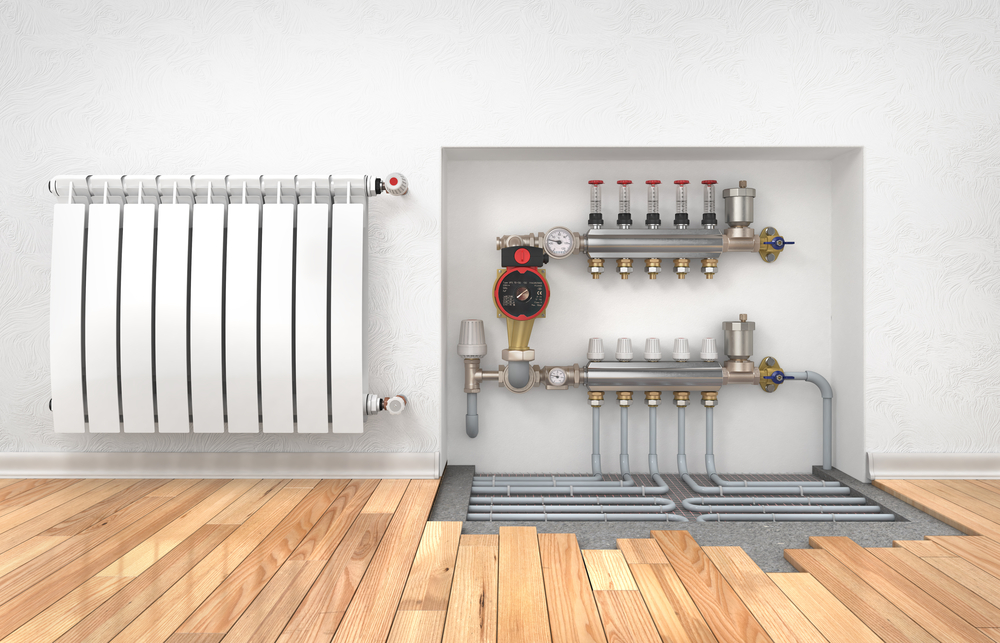Pros and Cons of Radiant Heating

In some countries, radiant flooring is still a relatively new system. However, it’s been on the market for a few years now.
It works by using a network of plastic tubing underneath the flooring and a layer of mortar board. Water, both hot or cold, can pass through these tubes and as a result, the floor heats up or cools down.
Because of the design, it’s normal that the lower areas are warmer than the higher ones in houses that use radiant heating. Also, the original flooring doesn’t interfere with this system.
If you have wood floors, you only need to make sure to install the tubing in a way that won’t bend the wood with temperature changes.
Below, we’d like to give you the main pros and cons of this heating system to consider before going ahead and installing it.

Pros of radiant heating
To begin, the tubing used in radiant heating is very thin, meaning that it requires less energy to heat up the water. Water of about 35-40ºC is all it needs, which is about half of what other heating systems require.
So, using radiant heating could cut back on your electricity consumption. It could save you about 10-20% what you’d consume with other systems.
In addition, renewable energy sources work hand in hand with radiant heating. The most common choices are aerothermal and geothermal energy. Radiant heating’s compatibility with these kinds of energy sources makes it one of the best heating systems for the environment.
It also frees up space because you don’t need radiators.
In addition, radiant heating works wonderfully in any part of the home, especially bathrooms.
You can also use radiant heating to cool off. It can be a way to replace fans and air conditioners.

You’ll also enjoy health benefits as radiant heating doesn’t create any air currents. As a result, it doesn’t generate any dust or dust mites.
Lastly, in the case of traditional radiators or similar heaters, heat builds up disproportionately in the areas of installation. However, using a radiant heating system will evenly distribute heat throughout the entire house.

Cons of radiant heating
First off, we need to mention that this is an expensive heating system to install. However, you can look at it as a long-term investment and pay it off over time.
For bigger houses, the price can be around 10,000 euros. The installation process in itself makes matters a little more complicated. You also have to consider maintenance.
Radiant heating isn’t recommended for houses that won’t use the system consistently. This is because the water takes a considerable amount of time to heat up or cool down. Unlike an electric radiator, you can’t use it whenever you want, turning it on for one day and not the next.
Of course, if you have a small house, the tubing will require less time to heat up or cool down.
As for the cooling system, it’s only recommended for areas of very low humidity. Otherwise the rooms can get a little humid or condensation could form on the floor. In any case, keeping the temperature under control during the summer is a good idea.
People with blood circulation problems in their legs might not benefit from this system. This is because it causes feet to get warm.
The last con to consider is that should a problem arise with the system, you’ll probably have to remove your entire flooring in that part of the house.
We hope that these pro and con lists help you make a decision about using radiant heating in your home. First, remember that it’s a great system for the environment This is something that doesn’t apply to most systems.
In addition, it can also provide some health benefits. Not to mention you can walk around your home barefoot, which makes us feel comfortable and snug.
Though installing radiant heating might seem expensive or difficult, remember that there are technical experts out there, just like there are for other maintenance or home projects.
In some countries, radiant flooring is still a relatively new system. However, it’s been on the market for a few years now.
It works by using a network of plastic tubing underneath the flooring and a layer of mortar board. Water, both hot or cold, can pass through these tubes and as a result, the floor heats up or cools down.
Because of the design, it’s normal that the lower areas are warmer than the higher ones in houses that use radiant heating. Also, the original flooring doesn’t interfere with this system.
If you have wood floors, you only need to make sure to install the tubing in a way that won’t bend the wood with temperature changes.
Below, we’d like to give you the main pros and cons of this heating system to consider before going ahead and installing it.

Pros of radiant heating
To begin, the tubing used in radiant heating is very thin, meaning that it requires less energy to heat up the water. Water of about 35-40ºC is all it needs, which is about half of what other heating systems require.
So, using radiant heating could cut back on your electricity consumption. It could save you about 10-20% what you’d consume with other systems.
In addition, renewable energy sources work hand in hand with radiant heating. The most common choices are aerothermal and geothermal energy. Radiant heating’s compatibility with these kinds of energy sources makes it one of the best heating systems for the environment.
It also frees up space because you don’t need radiators.
In addition, radiant heating works wonderfully in any part of the home, especially bathrooms.
You can also use radiant heating to cool off. It can be a way to replace fans and air conditioners.

You’ll also enjoy health benefits as radiant heating doesn’t create any air currents. As a result, it doesn’t generate any dust or dust mites.
Lastly, in the case of traditional radiators or similar heaters, heat builds up disproportionately in the areas of installation. However, using a radiant heating system will evenly distribute heat throughout the entire house.

Cons of radiant heating
First off, we need to mention that this is an expensive heating system to install. However, you can look at it as a long-term investment and pay it off over time.
For bigger houses, the price can be around 10,000 euros. The installation process in itself makes matters a little more complicated. You also have to consider maintenance.
Radiant heating isn’t recommended for houses that won’t use the system consistently. This is because the water takes a considerable amount of time to heat up or cool down. Unlike an electric radiator, you can’t use it whenever you want, turning it on for one day and not the next.
Of course, if you have a small house, the tubing will require less time to heat up or cool down.
As for the cooling system, it’s only recommended for areas of very low humidity. Otherwise the rooms can get a little humid or condensation could form on the floor. In any case, keeping the temperature under control during the summer is a good idea.
People with blood circulation problems in their legs might not benefit from this system. This is because it causes feet to get warm.
The last con to consider is that should a problem arise with the system, you’ll probably have to remove your entire flooring in that part of the house.
We hope that these pro and con lists help you make a decision about using radiant heating in your home. First, remember that it’s a great system for the environment This is something that doesn’t apply to most systems.
In addition, it can also provide some health benefits. Not to mention you can walk around your home barefoot, which makes us feel comfortable and snug.
Though installing radiant heating might seem expensive or difficult, remember that there are technical experts out there, just like there are for other maintenance or home projects.







